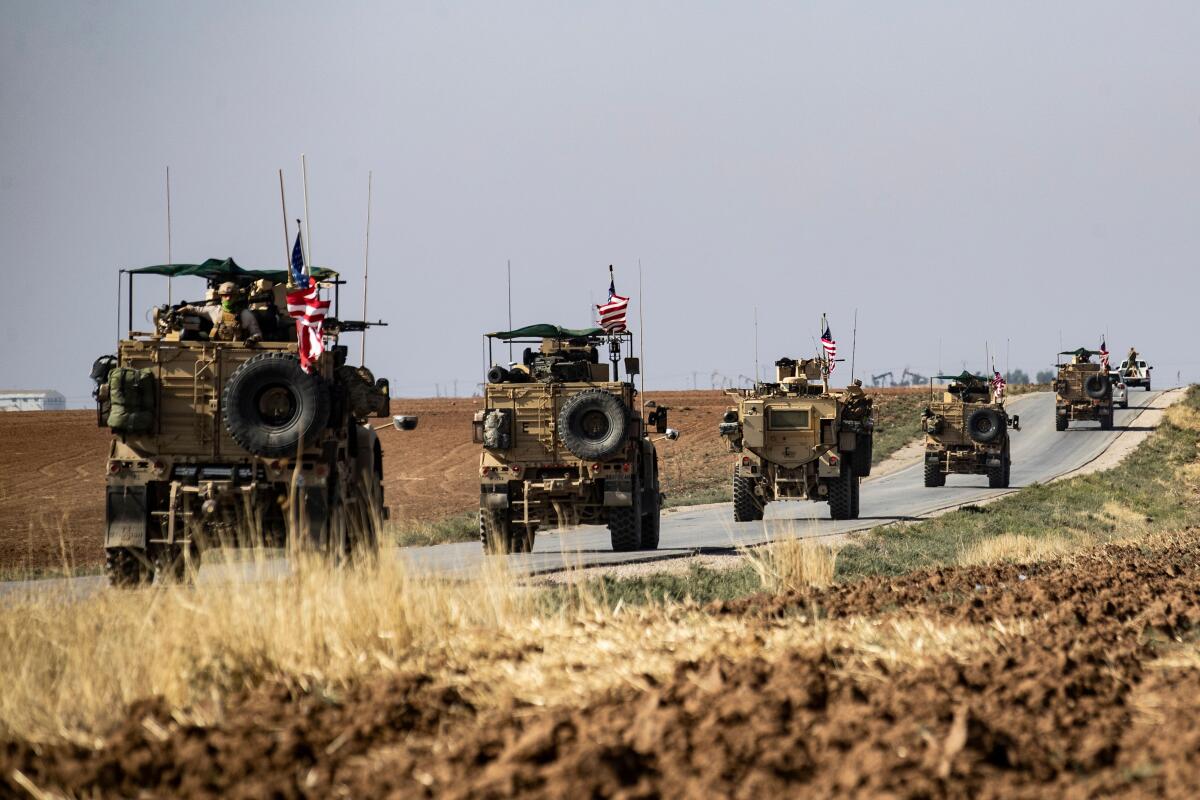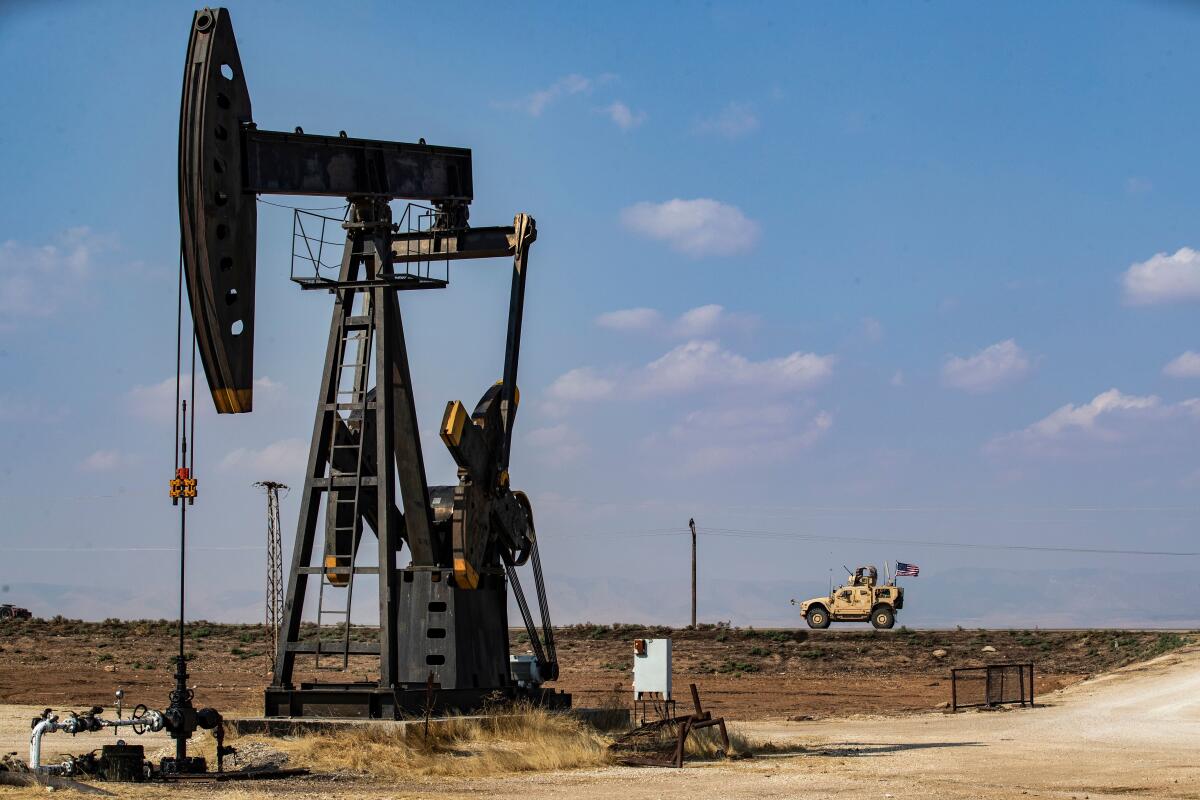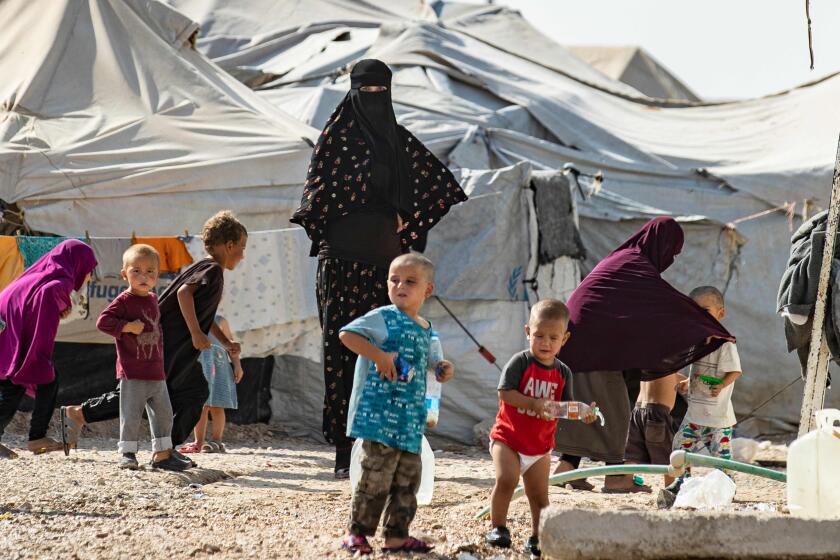Trump says he wants to keep Syria’s oil. Here’s the problem

- Share via
QAHTANIYA, Syria — The convoy of U.S. armored vehicles headed east, Stars and Stripes flapping in the wind as it lumbered toward its apparent destination — the oil fields of Rumeilan, in Syria’s far northeast.
There, pump jacks line both sides of the road, churning up and down. Smoke from small refineries rises into the sky and fires shoot from natural gas outlets. Electrical lines dot the landscape and tankers plod up and down the pothole-racked highway.
They’re the tattered vestiges of Syria’s long-crippled oil industry, which has become the latest justification for President Trump’s on-again, off-again policy to keep a U.S. presence in the country’s northeast.
“We want to bring our soldiers home. But we did leave soldiers because we’re keeping the oil,” said Trump on Friday, before adding, “I like oil. We’re keeping the oil.”
The problem is, there isn’t much oil to keep.
Syria was never a major oil producer on the international scale, accounting for a mere 385,000 barrels a day of crude, or 0.5% of global production in 2010, according to a report by British Petroleum’s Review of World Energy Report. That was the year before Syria’s protracted civil war began, ravaging all of the nation’s resources, including oil.

The country’s principal source of oil is in the eastern province of Dair Alzour. That is where Washington is reportedly dispatching new troops and Bradley fighting vehicles, according to the U.S.-led coalition operating in Syria. Traveling with them are militia fighters of the Kurdish-led Syrian Democratic Forces, which allied with the United States to help defeat Islamic State extremists. The militia has since allied itself with the Syrian government and Russia after the United States initially pulled out, allowing Turkish forces to storm across the border into the Kurdish-controlled region.
Hasakah province, already under the control of Kurdish-dominated militias, is also home to scattered oil production sites, of which Rumeilan is considered the largest. The Syrian Democratic Forces wrested control of oil facilities back from Islamic State in a series of battles.
Those battles have ravaged much of the production capacity, said Badran Jia Kurd, a senior official with the Syrian Kurds’ administration.
“The infrastructure is destroyed. More than 75% of these installations and wells aren’t ready for proper production,” Jia Kurd said in a phone interview Sunday. Local authorities don’t have the expertise to make meaningful repairs, he added.
What little is produced, said Jia Kurd (he demurred from giving specific numbers), is used for local consumption or given to traders, who resell part of it to the energy-starved government of Syrian President Bashar Assad. The oil proceeds have become the lifeblood of the quasi-statelet the Kurdish-led administration created in northeastern Syria, funding the Syrian Democratic Forces and its 140,000-strong bureaucracy as well as supporting an archipelago of prisons filled with Islamic State detainees.
His reign was marked with bouts of genocidal reengineering of communities that didn’t fit his vision for a Sunni Muslim state.
U.S. military officials say they want to secure the oil to deny Islamic State the chance to take back the fields and use them to fund its resurgence.
“It’s a subset of the counter-ISIS mission,” said U.S.-led coalition spokesman Col. Myles Caggins in an interview Monday. Islamic State is also known as ISIS. The militant group, which at its height controlled an oil operation spanning both Iraq and Syria, was largely defeated in a U.S.-backed offensive by the Syrian Democratic Forces this year.
Another justification for the U.S. presence is to deter Syrian and Russian forces from commandeering the oil fields, Defense Secretary Mark Esper said last week.
The day after Trump’s announcement, U.S. Army Oshkosh mine-resistant armored vehicles lumbered into Rumeilan and began patrolling areas of the northeast they had been ordered to abandon mere weeks ago.
The administration’s latest move, coming a few weeks after the president ordered the pullout of U.S. troops from the country, has flummoxed allies and adversaries alike.
Limited as the oil reserves are, Assad’s government — a U.S. foe — sees them as a boon. Syria has been suffering chronic fuel shortages under U.S. and European sanctions targeting its energy imports and has no money to fund its reconstruction efforts.
Since Trump’s reversal, a sort of do-si-do of military deployments has taken place, with U.S. troops shuttling in and out of the country into neighboring Iraq. In the last week, about 150 empty supply trucks were seen lined up outside a U.S. base along the M4 highway between the northeastern towns of Tal Baydar and Tal Tamr. Accompanying the sightings are Turkish and Syrian Kurdish news reports of the U.S. reopening some of the bases it had abandoned last month.
U.S. troops are situated not only near Syria’s oil fields, but also along main roads, such as the M4, which are key transport lines for oil and refined fuel. Any effort to produce oil would presumably mean increased patrols of these key roads, a complex task in a space with competing forces.
Turkish-backed militants are active in the area. Also present are Russian and Syrian government forces; their patrols have increased since last month’s Turkish-Russian deal mandating that Kurdish-led forces in Syria pull back to at least 19 miles from the border with Turkey.
Even if U.S. forces could secure the area, energy experts say, it’s unclear whether companies would be willing or even able to invest in rehabilitating the fields.
Many are legally owned by the Syrian state or in partnership with companies, including Total and Shell. Any company working there would open up a legal thicket on ownership rights even as it tries to navigate around easily tripped sanctions.
And what reserves there were to be extracted, said David Butter, an associate fellow and Middle East energy analyst at the London-based Chatham House think tank, were already in decline before the war.
So far, said Jia Kurd, the Kurdish official, there had been only preliminary discussions with companies. An Israeli businessman, Moti Kahana, claims his company, Global Development Corp., became the representative of the Kurdish-led administration for the sale of oil. He shared with The Times a letter from the Kurds saying his company also had “the right to explore and develop oil that is located in areas that we govern.”
Kurdish officials involved with the oil facilities refused to elaborate on arrangements set up regarding the extraction, sale and marketing of oil but said they were unchanged since Trump’s announcement.
Trump’s comments, meanwhile, have given ammunition to those who have always seen America’s Middle East policy as a vehicle for taking the oil.
On Saturday, Assad heaped sarcastic praise on Trump in an interview on state TV, calling him “the best American president.”
“Trump speaks with transparency to say ‘We want the oil.’ This is the reality of American politics since the Second World War at least,” said Assad.
“What do we want more than a transparent adversary?”
McDonnell reported from Qahtaniya and Bulos from Beirut.
More to Read
Sign up for Essential California
The most important California stories and recommendations in your inbox every morning.
You may occasionally receive promotional content from the Los Angeles Times.












